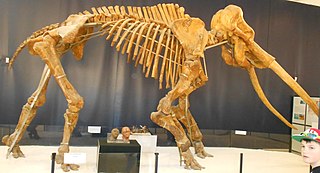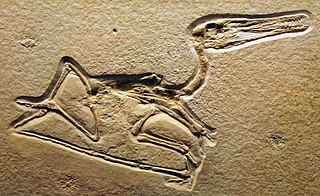
Pterodactylus is an extinct genus of pterosaurs. It is thought to contain only a single species, Pterodactylus antiquus, which was the first pterosaur to be named and identified as a flying reptile and one of the first prehistoric reptiles to ever be discovered.
Physeter is a genus of toothed whales. There is only one living species in this genus: the sperm whale. Some extremely poorly known fossil species have also been assigned to the same genus including Physeter antiquus from the Pliocene of France, and Physeter vetus from the Quaternary of the U.S. state of Georgia. Physeter vetus is very likely an invalid species, as the few teeth that were used to identify this species appear to be identical to those of another toothed whale, Orycterocetus quadratidens. The name is from Greek φυσητήρ (physētēr) 'blowpipe, blowhole .'

Palaeoloxodon is an extinct genus of elephant. The genus originated in Africa during the Pliocene-Early Pleistocene, and expanded into Eurasia at the beginning of the Middle Pleistocene. The genus contains some of the largest known species of elephants, over 4 metres (13 ft) tall at the shoulders, including the African Palaeoloxodon recki, the European straight-tusked elephant and the South Asian Palaeoloxodon namadicus. P. namadicus has been suggested to be the largest known land mammal by some authors based on extrapolation from fragmentary remains, though these estimates are highly speculative. In contrast, the genus also contains many species of dwarf elephants that evolved via insular dwarfism on islands in the Mediterranean, some only 1 metre (3.3 ft) in height, making them the smallest elephants known. The genus has a long and complex taxonomic history, and at various times, it has been considered to belong to Loxodonta or Elephas, but today is usually considered a valid and separate genus in its own right.

Pliopithecus {meaning "more ape") is a genus of extinct primates of the Miocene. It was discovered in 1837 by Édouard Lartet (1801–1871) in France, with fossils subsequently discovered in Switzerland, Slovakia and Spain.

Thecodontosaurus is a genus of herbivorous basal sauropodomorph dinosaur that lived during the late Triassic period.
"Coelosaurus" antiquus is a dubious species of theropod dinosaurs. It was named by Joseph Leidy in 1865 for two tibiae found in the Navesink Formation of New Jersey.

The straight-tusked elephant is an extinct species of elephant that inhabited Europe and Western Asia during the Middle and Late Pleistocene. Recovered individuals have reached up to 3.81–4.2 metres (12.5–13.8 ft) in shoulder height, and an estimated 11.3–15 tonnes in weight. Like modern elephants, the straight-tusked elephant lived in herds, flourishing during interglacial periods, when its range would extend as far north as Great Britain. Skeletons found in association with stone tools and wooden spears suggest they were scavenged and hunted by early humans, including Neanderthals. It is the ancestral species of most dwarf elephants that inhabited islands in the Mediterranean.

Diopecephalus is a genus of pterodactyloid pterosaur from the Lower Tithonian of the Lithographic Limestone, Bavaria, Germany. The type and only species is D. kochi, although the name has been applied to Pterodactylus longicollum, with longicollum erroneously listed as the type species.

Trox is a genus of hide beetle in the subfamily Troginae.

Trox contractus is a beetle of the Family Trogidae.

Trox tuberculatus is a beetle of the Family Trogidae.

TROX-1 is a drug which acts as a potent blocker of the Cav2 type calcium channels. It was developed as a potential analgesic after the discovery that the selective Cav2.2 blocker ziconotide is an active analgesic with similar efficacy to strong opioid drugs. Unlike ziconotide, TROX-1 is not so selective, and also blocks the Cav2.1 and Cav2.3 calcium channel subtypes, but it has the great advantage of being orally active, whereas ziconotide must be administered intrathecally, by injection into the spinal fluid. In animal studies of TROX-1, analgesic effects were observed with similar efficacy to NSAIDs such as naproxen or diclofenac, and anti-allodynia effects equivalent to pregabalin or duloxetine.

ViTrox Corporation Berhad is a Malaysian technology company headquartered in Penang, Malaysia. With a strong focus on machine vision and electronics, ViTrox specialises in the design and development of automated vision inspection systems and equipment for the semiconductor, printed circuit board assemblies, and electronics communication industries.
Trox laticollis is a species of hide beetle in the family Trogidae. It is found in North America.
Trox cadaverinus is a species of hide beetle in the subfamily Troginae. Within the genus Trox, it is placed in the core subgenus Trox.
Trox gansuensis is a species of hide beetle in the subfamily Troginae. Within the genus Trox, it is placed in the core subgenus Trox.
Trox horiguchii is a species of hide beetle in the subfamily Troginae. Within the genus Trox, it is placed in the core subgenus Trox.
Trox lutosus is a species of hide beetle in the subfamily Troginae. Within the genus Trox, it is placed in the core subgenus Trox.
Trox stellatus is a species of hide beetle in the subfamily Troginae. Within the genus Trox, it is placed in the core subgenus Trox.

Trox oustaleti is an extinct species of hide beetle in the subfamily Troginae described from a fossil found in the Ypresian age Allenby Formation of British Columbia, Canada. Within the genus Trox, it is placed in the core subgenus Trox.










